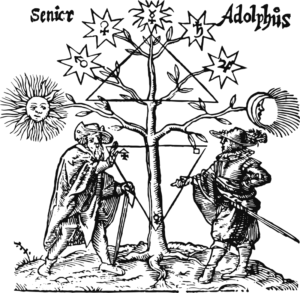
These books and manuscripts serve as primary sources for occult study. While some may be collections of older works, these editions and authors proved to be the most notable or influential. They are distinct from the Manuscripts page in that these works are usually readily available, reprinted, and translated for modern audiences. Occasionally something will be listed here if we don’t have the original (or if we only have fragments) but it is something that is consistently referred to by other authors and thus warrants mention. For works of fiction that were inspired by or feature occult elements, visit the page on Occult Literature. The sources listed here are for study, either by practitioners or academics. This list is far from exhaustive but should give you a general idea of what works were most important throughout history.
![]() Some of these listed sources have links to digitized versions of early manuscripts.
Some of these listed sources have links to digitized versions of early manuscripts.
![]() Primary sources provide the foundation for later interpretations. Depending on your area of study or practice, reading the original can allow you to create your own interpretation of the tradition.
Primary sources provide the foundation for later interpretations. Depending on your area of study or practice, reading the original can allow you to create your own interpretation of the tradition.

Antiquity (before 500 CE):
Greek Magical Papyri (c. 200 BCE – 400 CE, Ancient Greek, Coptic, and Demotic) – The name given to the manuscripts that contain various magical spells, hymns, and invocations created in the ancient Greco-Roman world. While common in the ancient world, such texts were systematically destroyed by early Christians.
![]() For a collection of papyri translated into English, see the cited volume at the end of the page.
For a collection of papyri translated into English, see the cited volume at the end of the page.
![]() Always practice caution when trying to recreate or perform any spells or rituals. Never do anything illegal, unsafe, or unethical. Be mindful of your physical, mental, and spiritual well-being when exploring new avenues for your craft.
Always practice caution when trying to recreate or perform any spells or rituals. Never do anything illegal, unsafe, or unethical. Be mindful of your physical, mental, and spiritual well-being when exploring new avenues for your craft.
The Book of Enoch (c. 100 BCE, Ge-ez language, fragments in Latin, Greek, and Aramaic) – Apocryphal ancient Hebrew text attributed to Enoch. John Dee claimed his system of “Enochian” magic revealed to him secrets hidden in this text.
![]() Practitioners who work with Christian or Judaic Angles, Demons, or Fallen Angels, or those who are interested in Enochian magic would do well to explore this text.
Practitioners who work with Christian or Judaic Angles, Demons, or Fallen Angels, or those who are interested in Enochian magic would do well to explore this text.
The Emerald Tablet (lost or mythical) – See the page on Alchemy for more information on this text. Despite its short length, this text has been hugely influential in alchemy, hermeticism, occult studies, and western esotericism. The full text is reproduced below, an English translation of Jabir ibn Hayyan’s Arabic version, from The Western Esoteric Traditions (full citation at the bottom of the page):
Chaldean Oracles (lost, only exists in fragments) – While the original text has been lost, fragments of it are preserved in quotations from later authors. The Oracles were highly influential to both Neoplatonic and Gnostic writers and philosophers.
![]()
Practitioners, beware of anyone who claims to have a “complete” or “restored” version of the Oracles. Scholars have collected editions of the available fragments and other sources attempt to recreate it in its entirety, but no one currently has access to a complete copy as it existed in antiquity.
Corpus Hermeticum (c. 200 CE, mostly Greek and Latin) – An assortment of texts produced in the Greco-Egyptian world in the first centuries CE. Later compiled by various scribes, translators, and authors. An influential compilation was translated by Marsilio Ficino in 1463.
![]() Scholars, see specifically Brian P. Copenhaver’s English translation Hermetica (full citation at the bottom of the page).
Scholars, see specifically Brian P. Copenhaver’s English translation Hermetica (full citation at the bottom of the page).
The Enneads (c. 270 CE – Ancient Greek) – Neoplatonic texts by Plotinus, compiled and edited by his student Porphyry.

Middle Ages (500-1500 CE):
Psuedo-Dionysius Corpus (late 5th to early 6th century, Latin) – Writing under a pseudonym, an unknown author merged Neoplatonic philosophy with Christian theology (no small feat of mental gymnastics, considering their incongruities). Aside from being hugely influential in the following centuries, it was one of the only sources of Platonic or Neoplatonic philosophy in Europe until the fifteenth century. Particularly interesting topics from the corpus include: Angelic hierarchy, negative theology, and mystical theology.
Picatrix (c. 10th century, Arabic, later Spanish and Latin) – In the western world this work is know by its Latinized name, Picatrix, but the original Arabic title is Ghāyat al-Ḥakīm. Despite it being lesser known compared to other foundational texts, “The Goal of the Sage” (the English translation of the Arabic title) was a key inspiration for later figures such as Ficino and Agrippa.
Malleus maleficarum (1487 – Latin) – Typically translated as “The Hammer of Witches”, see the Witchcraft and Wicca page for more information on this inquisitor’s manual for hunting down, exposing, interrogating, and punishing purported witches. This source was influential for all the wrong reasons.
Library digitized version of “Malleus Maleficarum”

Early Modern Period (1500-1750):
![]() Three Books of Occult Philosophy – (1531, Latin) Heinrich Cornelius Agrippa’s massive work covers varied topics from angelology, astrology, alchemy, to ritual magic and beyond. Collected from a wide range of sources and perspectives, Agrippa is careful to contextualize everything to align with Christian doctrine.
Three Books of Occult Philosophy – (1531, Latin) Heinrich Cornelius Agrippa’s massive work covers varied topics from angelology, astrology, alchemy, to ritual magic and beyond. Collected from a wide range of sources and perspectives, Agrippa is careful to contextualize everything to align with Christian doctrine.
Daemonologie (1597, Middle English) – This work by King James VI of Scotland (later James I of England) was meant to inform the populace on the “truth” of demons, witches, sorcery, and other such malicious entities. James organizes the different categories of demons and types of magic as well as detailing the nuances of investigating reported witchcraft.
Digitized copy from the British Library
![]() Paracelsus (16th century, mostly Latin) – The Swiss physician Theophrastus von Hohenheim, known as Paracelsus, wrote on such a wide range of topics and his subsequent influence on both medicine and occult studies is a complicated web at so many points that it’s difficult to recommend any particular work of his. Most of his writings remained unpublished during his lifetime for their controversial contents. Practitioners will find him mostly tangentially related to their study, while scholars will find a wealth of opportunity amongst his corpus.
Paracelsus (16th century, mostly Latin) – The Swiss physician Theophrastus von Hohenheim, known as Paracelsus, wrote on such a wide range of topics and his subsequent influence on both medicine and occult studies is a complicated web at so many points that it’s difficult to recommend any particular work of his. Most of his writings remained unpublished during his lifetime for their controversial contents. Practitioners will find him mostly tangentially related to their study, while scholars will find a wealth of opportunity amongst his corpus.
The University of Zurich’s Paracelsus Project (a good resource for more advanced study on his writings)
The Book of Abramelin (c. early 17th century, German) – Set in 1458, the story of Abraham of Worms’ journey from Germany to Egypt to receive secret rituals is the centerpiece of this mysterious text. The oldest evidence of the book dates to the early 17th century and it was likely written in German before it was translated to various other languages. Regardless of its origins, this grimoire has proven popular from its use by the Order of the Golden Dawn, to Aleister Crowley’s Thelema, up to modern ritual magic.
Utriusque cosmi maioris scilicet et minoris metaphysica (1617, Latin) – English physician and occult enthusiast Robert Fludd’s magnum opus, Utriusque cosmi defies any easy summary of its contents. Fludd’s cosmology and philosophy were influenced by the Rosicrucians, Paracelsus, and his contemporary understanding of science and occult forces.
Digitized copy from Archive.org
Writings of John Dee (late 1500s-early 1600s, English and Latin) – Court advisor to Queen Elizabeth I and progenitor of Enochian ritual magic, Dee’s own writings are nearly overshadowed by the vast library he owned during his lifetime. While his library and manuscripts were scattered to various owners, libraries, and museums after his death, the British Library’s Sloane collection features some of the more interesting items. Since these are not digitized in their online archive, most people will have to rely on transcriptions and secondary sources for the content of his own writings.
Sloane MS 2327 – Collection of Alchemical works owned by John Dee
Sloane MS 3188 – John Dee’s conferences with angels
Sloane MS 3191 – John Dee’s notes on ceremonial magic
Writings of Giordano Bruno (d. 1600, Latin and Italian) – Much like Paracelsus, Bruno’s influence stems more from his overall philosophy spread throughout his various works rather than any particular piece. Burnt at the stake for the crime of heresy, this Italian friar has been held as a revolutionary for both science and esotericism in near equal measure.
Bruno received a second wave of influence after the publication of historian Frances Yates’ book, Giordano Bruno and the Hermetic Tradition in 1964. While Yates argued for the hermetic and Neoplatonic influences in Bruno’s writing, and their influence on the Renaissance milieu as a whole, later scholarship has challenged her conclusions.
Giordano Bruno – Entry from the Stanford Encyclopedia of Philosophy
Yates and Bruno – Article from the Warburg Institute
Three Anonymous Rosicrucian Manifestos (early 17th century, German) – The Fama Fraternitatis (1614), Confessio Fraternitatis (1615), and Chymische Hochzeit Christiani Rosencreutz (1616) are the titles of the three anonymous “manifestos” that started the Rosicrucian mania first in Germany then across Europe. The influence of, debates on, and secrets revolving around the hermetically inspired texts are ongoing.
Herbert Silberer examines the “Chemical Wedding” in his work Problems of Mysticism. See the page on Alchemy and Psychoanalysis for more details related to his particular interpretation.
Musaeum hermeticum reformatum et amplificatum (1625 in German, 1678 expanded in Latin) – The “Hermetic Museum” is a collection of alchemical works collected and published by German engraver Lucas Jennis.
Archive.org digitized version “Dyas chymica tripartita…” (German version)
Archive.org digitized version of “Musaeum Hermeticum” (Latin version)

Late Modern (1750-1945):
Heaven and Hell (1758, Latin) – Emanuel Swedenborg, the Swiss mystic and theologian, recounts his journey through Heaven and Hell.
An English edition from archive.org
Archive.org has quite a few of Swedenborg’s works available
Dictionnaire Infernal (1818, French) – Published by French occultist Jacques Collin de Plancy in 1818, this “Infernal Dictionary” featured a number of demons, their descriptions, and classifications. It is most known for its illustrated 1863 edition.
Archive.org digitized version of “Dictionnaire Infernal” (1863 edition with illustrations)
The Kybalion (1908, English) – Published under the name “Three Initiates”, this book became a popular source for hermetic philosophy. Since it entered the public domain in 1977, this work is easy to find in its entirety online.

Contemporary (1945-present):
The Satanic Bible (1969, English) – Anton LaVey’s primary work for explaining his Church and Satanic philosophy. While LaVey’s criticism of religion and society has valid points, the work has a distinct quality of misanthropy that makes it difficult to accept in its entirety (although this may just be my particular reading of it). For more information, check the relevant section on the Practitioners’ Guide page.
![]()
Bibliography
Betz, Hans Dieter. ed. The Greek Magical Papyri in Translation. University of Chicago Press, 1986.
Copenhaver, Brian P. Hermetica. Cambridge University Press, 1992.
Corrigan, Kevin and L. Michael Harrington, “Pseudo-Dionysius the Areopagite”, The Stanford Encyclopedia of Philosophy (Winter 2019 Edition), Edward N. Zalta (ed.), https://plato.stanford.edu/archives/win2019/entries/pseudo-dionysius-areopagite/
Dillon, John Myles, and Lloyd P. Gerson, translators. Neoplatonic Philosophy: Introductory Readings. Hackett Publishing Company, 2007.
Goodrick-Clarke, Nicholas. The Western Esoteric Traditions: A Historical Introduction. Oxford University Press, 2008.
Greer, John Michael, and Christopher Warnock. Picatrix: The Classic Medieval Handbook of Astrological Magic. Adocentyn Press, 2011.
Knox, Dilwyn, “Giordano Bruno”, The Stanford Encyclopedia of Philosophy (Summer 2019 Edition), Edward N. Zalta (ed.), https://plato.stanford.edu/archives/sum2019/entries/bruno/
LaVey, Anton Szandor. The Satanic Bible. Avon Books, 2005.
Pseudo-Dionysius, The Complete Works. Translated by Colm Luibheid, Paulist Press, 1987.


